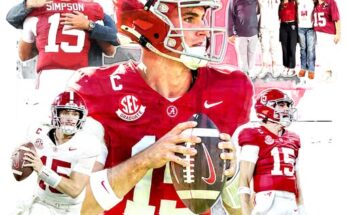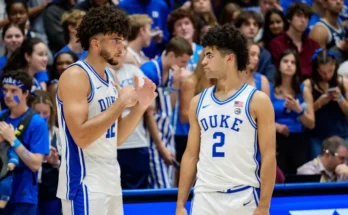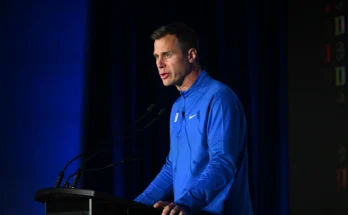Navigating the New Terrain: How College Football’s Transfer Boom is Reshaping NFL Draft Evaluations
The landscape of college football has undergone a seismic shift in recent years, primarily due to the advent of the transfer portal and the introduction of Name, Image, and Likeness (NIL) agreements. These changes have not only transformed the collegiate athletic experience but have also significantly impacted the way NFL scouts and general managers evaluate talent for the draft. The increased mobility of players has introduced both opportunities and challenges, creating a complex environment for talent assessment.
The transfer portal, established in 2018, allows college athletes to enter their names into a database, signaling their intent to transfer to another institution. This system grants players greater autonomy over their collegiate careers, enabling them to seek programs that better align with their athletic and academic goals. The subsequent introduction of NIL agreements in 2021 further empowered athletes, allowing them to monetize their personal brands while still in college. Together, these developments have led to an unprecedented level of player movement across the collegiate landscape.
For NFL evaluators, this newfound fluidity presents a unique set of challenges. Traditionally, scouts could track a player’s development within a single program, gaining a comprehensive understanding of their growth, adaptability, and performance against consistent competition. Now, with players transferring more frequently, evaluators must assess how changes in coaching, competition level, and team dynamics have influenced a player’s performance and potential.
Andrew Berry, General Manager of the Cleveland Browns, has noted the implications of this trend. He highlighted that the transfer portal has led to a more dynamic evaluation process, where understanding the context of a player’s transfer is crucial. Berry emphasized the importance of discerning whether a player’s move was driven by a desire for increased playing time, a better scheme fit, or other factors. This insight is vital in projecting how a player might adapt to the professional environment .
The impact of the transfer portal is particularly pronounced when evaluating small-school prospects. Historically, standout athletes from smaller programs faced an uphill battle in gaining national recognition and securing high draft positions. The transfer portal has altered this dynamic by providing these players with opportunities to showcase their talents on larger stages. By transferring to more prominent programs, they can compete against higher-caliber opponents, thereby enhancing their visibility and draft stock.
However, this shift has also led to a decrease in the number of small-school prospects entering the NFL directly from lesser-known programs. With top talents opting to transfer to larger schools, NFL teams are less inclined to scout smaller programs, potentially overlooking hidden gems who choose to remain. This trend underscores the need for scouts to maintain a broad and inclusive approach to talent evaluation .
The case of Cam Ward exemplifies how the transfer portal and NIL opportunities can converge to elevate a player’s draft prospects. Ward began his collegiate career at Incarnate Word, an FCS program, where he demonstrated exceptional talent as a quarterback. Seeking greater exposure and competition, he transferred to Washington State, a Power 5 school, and later to the University of Miami. Throughout this journey, Ward leveraged NIL deals to support his transitions and development. His performance at Miami, culminating in an impressive Pro Day, has positioned him as a potential top pick in the upcoming NFL Draft .
This evolving landscape necessitates that NFL scouts and general managers adapt their evaluation strategies. Assessing a player’s trajectory now requires a nuanced understanding of their reasons for transferring, the impact of different coaching styles, and how various competitive environments have shaped their skills and resilience. Additionally, evaluators must consider the influence of NIL commitments on a player’s focus and development.
Furthermore, the increased prevalence of transfers has led to more complex team dynamics at the collegiate level. Players who have experienced multiple systems may bring a diverse skill set and adaptability, but concerns about their ability to integrate into a cohesive unit may arise. NFL teams must weigh these factors carefully, balancing the potential benefits of a player’s varied experiences against the need for stability and consistency.
The transfer boom has also influenced the timing of players declaring for the draft. With the opportunity to earn through NIL deals, some athletes may choose to extend their college careers, refining their skills and increasing their draft stock. Conversely, others might declare earlier, leveraging high-profile performances at prominent programs to enter the professional ranks sooner. This variability adds another layer of complexity to the evaluation process, as teams must project not only current abilities but also future potential and readiness.
In response to these challenges, NFL organizations are investing more resources into understanding the collegiate landscape. Building relationships with college coaches, monitoring transfer trends, and analyzing the impact of NIL deals have become integral components of the scouting process. Teams are also placing greater emphasis on psychological assessments to gauge how players have handled transitions and adversity, providing insights into their mental toughness and adaptability.
Ultimately, the transformation of college football through the transfer portal and NIL agreements reflects a broader shift toward player empowerment and mobility. While this evolution presents challenges for NFL talent evaluators, it also offers opportunities to discover and develop talent in new and innovative ways. By embracing the complexities of this unique landscape, NFL teams can enhance their scouting acumen and make more informed decisions that reflect the dynamic nature of modern collegiate athletics.



